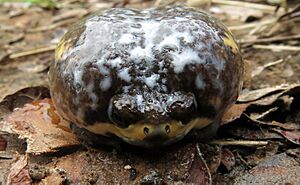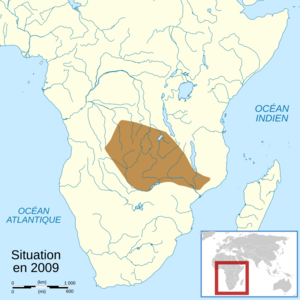Power's rain frog facts for kids
Quick facts for kids Power's rain frog |
|
|---|---|
 |
|
| Conservation status | |
| Scientific classification | |
 |
The Power's rain frog (also known as Power's short-headed frog) is a special type of frog. Its scientific name is Breviceps poweri. This frog belongs to a family called Brevicipitidae, which are often known as rain frogs. You can find these frogs in parts of Africa, including northeastern Angola, Zambia, southern Democratic Republic of the Congo, Malawi, western Mozambique, and northeastern Zimbabwe. They might even live in Namibia. The frog was named poweri to honor John Hyacinth Power. He was an Irish director of the McGregor Museum in Kimberley, South Africa, and he studied many animals and plants.
Contents
Life and Habits of the Rain Frog
Power's rain frogs are quite interesting creatures. They usually stay hidden underground. But after it rains, they come out! They do this to find food and to reproduce.
What Power's Rain Frogs Eat
These frogs are not picky eaters. They mostly munch on small insects. Their favorite foods include ants, termites, and other tiny creatures called arthropods.
Sounds and Reproduction
Male Power's rain frogs make special calls. They start singing in the early evening. Their calls can continue all through the night! The sound is a short, clear whistle. It starts softly, gets louder, and then quickly fades away. These calls are important for finding a mate. Reproduction also happens during the rainy season.
Where Power's Rain Frogs Live
Power's rain frogs are fossorial animals. This means they spend most of their lives digging and living underground.
Their Favorite Homes
You can find these frogs in different types of habitats. They like savanna woodlands, areas with shrubs, and grasslands. The most important thing for them is sandy soil. This type of soil is easy for them to dig in.
Why They Don't Need Water
Unlike many other frogs, Power's rain frogs do not need to be near water to lay their eggs. This is because they have a special way of reproducing called "direct development." Their eggs hatch directly into tiny froglets. There is no tadpole stage that needs water.
How They Are Protected
The International Union for Conservation of Nature (IUCN) has looked at the Power's rain frog. They have listed it as a species of "Least Concern". This is good news! It means the frog is not currently in danger of disappearing. It is a very common species in many areas. These areas often have little human activity. Plus, many Power's rain frogs live in protected areas.


